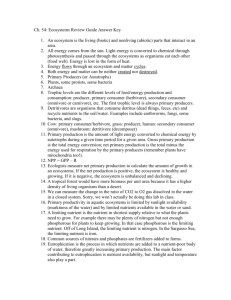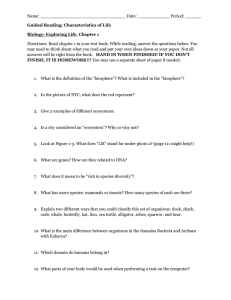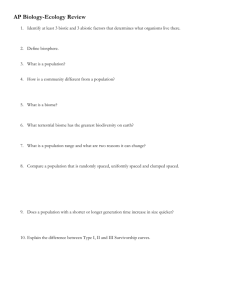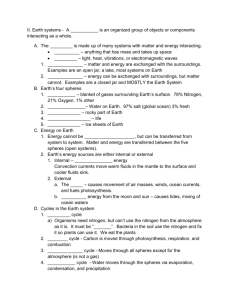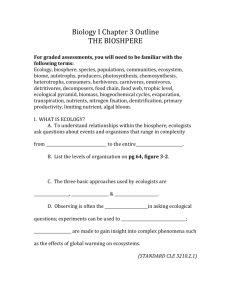Environmental Science - Winston Knoll Collegiate
advertisement
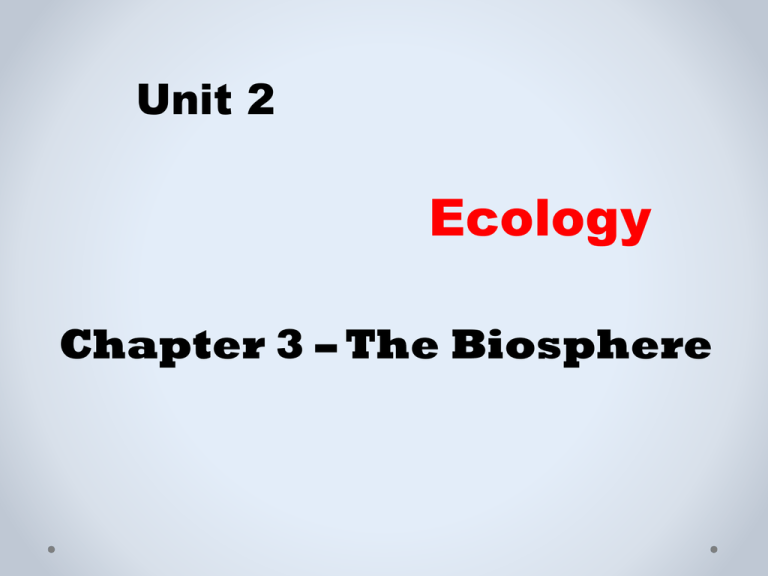
Unit 2 Ecology Chapter 3 – The Biosphere Introduction to Ecology Ecology - the scientific study of interactions among organisms and between organisms and their physical environment. Ecologist - a scientist who studies organisms as they interact with other organisms within an ecosystem Levels of Organization Individual Organism Population—a group of individuals that belong to the same species and live in the same area Community—an assemblage of different populations that live together in a defined area Ecosystem—all the organisms that live in a place, together with their physical environment Biome—a group of ecosystems that share similar climates and typical organisms Biosphere—our entire planet, with all its organisms and physical environments Types of Ecosystems Natural Ecosystems Self sustaining Precipitation Sunlight All resources to support life Destroyed by natural disasters (fires) Human-Made Ecosystems Not self sustaining Farms Cities Flower gardens Aquariums Zoo Huge inputs of resources and energy Relationships Within an Ecosystem •An ecosystem is a group of organisms that live together and interact with each other and their environment. •Organisms respond to their environments and can change their environments, producing an everchanging biosphere. Biotic Factors Anything living in an ecosystem! List three example of biotic components in an ecosystem and how they interact? Abiotic Factors • Anything nonliving! ▫ List three example of abiotic components in an ecosystem and why they are important? Biomes • A large geographic region determined by climate, soil type and plant life. oWhy is plant life so important to an ecosystem? Biomes Arctic Tundra Desert Northern Coniferous Forest or Taiga Temperate Deciduous Forest Tropical Savanna Temperate Grasslands or Prairie Tropical Rain Forest Population Studies: factors that affect the size of a population 1. Carrying capacity: The maximum size of the population that an ecosystem can hold 2. Limiting factors: Anything that prevents the population size from increasing Examples ? Food Chains and Food Webs o How does energy flow through ecosystems? o Energy flows through an ecosystem in a one-way stream, from primary o producers to various consumers. Energy moves from the “eaten” to the “eater.” Where it goes from there depends on who eats whom! Food Chain The arrows in a food chain show what eats what. The arrow replaces the phrase “is eaten by”. The arrow must point toward the “eater”. Leaf Grasshopper Frog Heron Food Webs • This is who eats who or what in the ecosystem. Each organism has a “job title” that describes their role. Anything that affects one level will probably affect the entire ecosystem! Food Web A food web shows the many possible food chains that exist in an ecosystem. Food Webs “Job Titles” • Producers- Plants. They are the basis for life in the ecosystem. • These organisms are also called autotrophs. Most Producers get Energy From the Sun The best-known and most common primary producers harness solar energy through the process of photosynthesis. Photosynthesis captures light energy and uses it to power chemical reactions that convert carbon dioxide and water into oxygen and energy-rich carbohydrates. This process adds oxygen to the atmosphere and removes carbon dioxide. Most photosynthesis occurs in plants on land and algae in water ecosystems. Life Without Light Deep-sea ecosystems depend on primary producers that harness chemical energy from inorganic molecules such as hydrogen sulfide. The use of chemical energy to produce carbohydrates is called chemosynthesis. Food Webs “Job Titles” • Consumers- these organism eat other organisms. They can not make their own food, therefore, they must “order out”! • Organisms that must acquire energy from other organisms by ingesting in some way are also known as heterotrophs. Food Webs “Job Titles” •Consumers may be herbivores (plant eaters), carnivores (meat eaters) or omnivores (both) •Carnivores are usually referred to as predators! Food Webs “Job Titles” ▫ 1st or PRIMARY level consumers are herbivores ▫ 2nd or SECONDARY level consumers are carnivores or omnivores and eat 1st order consumers ▫ What are 3rd order (level) consumers? Food Webs “Job Titles” • Decomposers- These are the recycling centers of the ecosystem. They breakdown dead organisms into nutrients in the soil that plants can use as vitamins. ▫ Bacteria and Fungus • Detritivores, feed on detritus particles (what is left from the decomposers,) often chewing or grinding them into smaller pieces. giant earthworms Food Webs “Job Titles” Scavengers- Similar to decomposers because they eat already dead organisms and return nutrients to the soil. Animals, birds, insects Trophic Levels and Ecological Pyramids o Each step in a food chain or food web is called a trophic level. • Primary producers always make up the first trophic level. • Various consumers occupy every other level. Some examples are shown. o Ecological pyramids show the relative amount of energy or matter contained within each trophic level in a given food chain or food web. Advantages and Disadvantages of the Pyramids • Pyramids of numbers and biomass can sometimes be inverted due to certain situations within ecosystems • These inverted pyramids then lose their ability to accurately represent the passage of energy from one trophic level to the next Pyramid of Numbers • This represents the number of organisms that occupy each trophic level http://openlearn.open.ac.uk Pyramids of Energy o Pyramids of energy show the relative amount of energy available at each trophic level. o On average, about 10 percent of the energy available within one trophic level is transferred to the next trophic level. o The more levels that exist between a producer and a consumer, the smaller the percentage of the original energy from producers that is available to that consumer. Pyramid of Biomass o The total amount of living tissue within a given trophic level is called its biomass. o A pyramid of biomass illustrates the relative amount of living organic matter at each trophic level. Recycling in the Biosphere o Unlike the one-way flow of energy, matter is recycled within and between ecosystems. o Elements pass from one organism to another and among parts of the biosphere through closed loops called biogeochemical cycles, which are powered by the flow of energy. • Biogeochemical cycles of matter involve biological processes, geological processes, and chemical processes. Recycling in the Biosphere o As matter moves through these cycles, it is never created or destroyed—just changed. • Biogeochemical cycles of matter pass the same atoms and molecules around again and again. Water Cycle • Also called the Hydrologic Cycle • Movement and storage of water on the planet o Total amount of water doesn’t change – it is transported around the earth o Energy to run the cycle comes from the sun • Water re-enters that atmosphere by two processes o Evaporation changes surface water (lakes, rivers, oceans) to water vapor • Water vapor (gaseous state) returns to the atmosphere o Transpiration is the loss of water vapor from the leaves of plants • Stomata are openings in leaves which allow the water vapor out of the plant • Condensation o As the water vapor rises in the atmosphere, it looses energy (cools down) o Water droplets are formed from the water vapor • Precipitation o When the water droplets get too heavy it falls from the sky o Weather conditions determine the type of precipitation – rain, snow, sleet • Some precipitation re-evaporates before it reaches the ground • Most precipitation falls into existing bodies of water o 70% of the earth’s surface is water • The rest falls on land o Absorbed into the soil or flows over the surface as Runoff (back to the oceans/lakes) o Infiltration is the process of water entering the ground The cycle begins again: o Evaporation and transpiration o Condensation o Precipitation o Runoff and Infiltration The amount of precipitation is an important factor in the type of ecosystem and the population of organisms it can support Nutrient Cycles o The chemical substances that an organism needs to sustain life are called nutrients. o Every organism needs nutrients to build tissues and carry out life functions. o Nutrients pass through organisms and the environment through biogeochemical cycles. The Carbon – Oxygen Cycle o Carbon is a major component of all organic compounds, including carbohydrates, lipids, proteins, and nucleic acids. The Carbon – Oxygen Cycle • Plants take in carbon dioxide during photosynthesis and use the carbon to build carbohydrates. • Carbohydrates then pass through food webs to consumers. • Organisms release carbon in the form of carbon dioxide gas by respiration. The Nitrogen Cycle o All organisms require nitrogen to make amino acids, which are used to build proteins and nucleic acids, which combine to form DNA and RNA. The Nitrogen Cycle o Nitrogen-containing substances such as ammonia (NH3), nitrate ions (NO3), and nitrite ions (NO2) are found in soil, in the wastes produced by many organisms, and in dead and decaying organic matter. The Nitrogen Cycle o Nitrogen gas (N2) makes up 78 percent of Earth’s atmosphere. • Although nitrogen gas is the most abundant form of nitrogen on Earth, only certain types of bacteria that live in the soil and on the roots of legumes can use this form directly. o The bacteria convert nitrogen gas into ammonia, in a process known as nitrogen fixation. The Nitrogen Cycle o Other soil bacteria convert fixed nitrogen into nitrates and nitrites that primary producers can use to make proteins and nucleic acids. o Consumers eat the producers and reuse nitrogen to make their own nitrogen-containing compounds The Nitrogen Cycle o Consumers eat the producers and reuse nitrogen to make their own nitrogen-containing compounds. o Decomposers release nitrogen from waste and dead organisms as ammonia, nitrates, and nitrites that producers may take up again. The Nitrogen Cycle o Other soil bacteria obtain energy by converting nitrates into nitrogen gas, which is released into the atmosphere in a process called denitrification. o A small amount of nitrogen gas is converted to usable forms by lightning in a process called atmospheric nitrogen fixation. o Humans add nitrogen to the biosphere through the manufacture and use of fertilizers. Excess fertilizer is often carried into surface water or groundwater by precipitation. The Phosphorus Cycle o Phosphorus forms a part of vital molecules such as DNA and RNA. o Although phosphorus is of great biological importance, it is not abundant in the biosphere. o Phosphorus in the form of inorganic phosphate remains mostly on land, in the form of phosphate rock and soil minerals, and in the ocean, as dissolved phosphate and phosphate sediments. The Phosphorus Cycle o As rocks and sediments wear down, phosphate is released o Plants bind phosphate into organic compounds when they absorb it from soil or water. o Organic phosphate moves through the food web, from producers to consumers, and to the rest of the ecosystem. Nutrient Limitation o Ecologists are often interested in an ecosystem’s primary productivity—the rate at which primary producers create organic material. o A nutrient whose supply limits productivity is called the limiting nutrient. ▫ All nutrient cycles work together like the gears shown. ▫ If any nutrient is in short supply—if any wheel “sticks”— the whole system slows down or stops altogether. Nutrient Limitation in Aquatic Ecosystems o Sometimes an aquatic ecosystem receives a large input of a limiting nutrient—for example, runoff from heavily fertilized fields. o The result of this runoff can be an algal bloom—a dramatic increase in the amount of algae and other primary producers due to the increase in nutrients.
